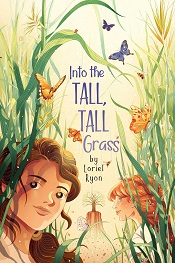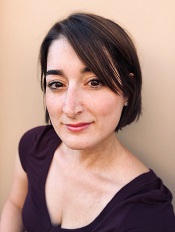- Categories:
An Indies Introduce Q&A With Loriel Ryon [4]
 Loriel Ryon is the author of Into the Tall, Tall Grass (Margaret K. McElderry Books), a Winter/Spring 2020 Indies Introduce [5] middle-grade selection and a Spring 2020 Kids’ Indie Next List [6] pick.
Loriel Ryon is the author of Into the Tall, Tall Grass (Margaret K. McElderry Books), a Winter/Spring 2020 Indies Introduce [5] middle-grade selection and a Spring 2020 Kids’ Indie Next List [6] pick.
Riley Jay Davis of Next Chapter Booksellers [7] in St. Paul, Minnesota, served on the panel that selected Ryon’s book for Indies Introduce. Davis called the debut “a touching and sad story with a great take on magical realism — a tradition of Latin literature. Yolanda and her friends are unique characters from each other and give any reader a character they can relate to. It's got it all — queer characters, STEM, magic, frenemies, legends, and mysteries.”
Ryon grew up in a mixed-heritage military family and spent much of her childhood with her nose in a book. She is now a nurse and lives in the desert of New Mexico with her husband and daughters. Here, Davis and Ryon discuss the relationship between magic and science, as well as the relationships between the main characters in the author’s story.
Riley Jay Davis: Who were you thinking of when you wrote this book? What kind of reader do you hope will see themselves in this?
 Loriel Ryon: I was thinking of myself as a kid and what I was craving to read at that age. I wanted to read about a kid like me, who had a Caucasian dad and a Mexican American mom. I wanted to read about a kid who was afraid of losing their grandparents and came to understand that painful reality. I wanted to read about a kid who was stubborn and lonely and wanted to change but couldn’t figure out how to do it. A kid who came out of a tough situation better for it and stronger. I wanted a story about grief and loss that was truthful and hopeful. I want to reach any reader who is learning to come to terms with all the life changes and realizations that happen as we come of age.
Loriel Ryon: I was thinking of myself as a kid and what I was craving to read at that age. I wanted to read about a kid like me, who had a Caucasian dad and a Mexican American mom. I wanted to read about a kid who was afraid of losing their grandparents and came to understand that painful reality. I wanted to read about a kid who was stubborn and lonely and wanted to change but couldn’t figure out how to do it. A kid who came out of a tough situation better for it and stronger. I wanted a story about grief and loss that was truthful and hopeful. I want to reach any reader who is learning to come to terms with all the life changes and realizations that happen as we come of age.
RJD: The relationships between the characters are complex and nuanced. Why did you make this choice with such young protagonists?
LR: Because real life is complex and nuanced. I wanted this story to reflect those realities even with young protagonists. This is my favorite age group to write for, because as we are coming of age our understanding of ourselves, our worlds, and our families explodes. We become aware of the fact that our parents and grandparents are not perfect people, but humans with flaws who make mistakes and have complicated relationships with each other. We also start to learn that about ourselves. Just because kids are young doesn’t mean their understanding of the world is simple. Their relationships with their friends, siblings, and parents changes during this time. Sometimes we resist the changes and it feels like the end of the world. I wanted to bring truth to that complicated time in one’s life.
RJD: What role does magical realism play in Into the Tall, Tall Grass?
LR: Magical realism in this story has many roles. It’s there to disrupt the expected and push the characters out of their comfort zone. It’s there to cause conflict between Yolanda and her family, between Yolanda and herself. It’s there to illuminate family heritage. It’s there to pinpoint the magic in everyday life that we often overlook. It’s there to demonstrate healing and hope and wonderment.
RJD: Despite the use of magical realism, there is also a lot of use of STEM in the book. How do these two interact with each other?
LR: When writing this book, I knew it had to include science. I love science and my first degree is in biology. It was always my favorite subject in school. I remember learning about genetics and cellular biology for the first time and being absolutely amazed at how things fit together. It was like the earth cracked open, and I finally began to understand the world. I remember that day so vividly. Something inside me shifted, and I wondered how this information had been there all along…what else didn’t I know?
It was magic.
When I set out to write Into the Tall, Tall Grass, I wasn’t quite sure how I was going to do it. How would I make science and magic, two seemingly opposite things, work together? So, I went back to the basics and asked myself a few questions.
What is more magical than the fractal pattern on a pinecone or a snail’s shell? What is more magical than understanding how genetic traits are passed through a family line? What is more magical than how DNA replicates? What is more magical than nature?
I recently read a quote by Salman Rushdie in an article he wrote about Gabriel García Márquez’s work. This was where everything clicked for me: “It’s because the magic in magic realism has deep roots in the real, because it grows out of the real and illuminates it in beautiful and unexpected ways, that it works.”
The truth is, science is magic.
RJD: What is one thing you want people to feel once they're finished with the book?
LR: I want readers to feel hope. I want them to finish it and feel that even after going through really difficult and tough things there is always hope. There will be others to help you pick up the pieces and move on, but you have to let them in.
I want readers to hold hope within themselves, too. Even if you are so sure you can’t possibly change. Or you really messed things up and everything is ruined, I wanted readers to know that you can change. We all have the capacity to grow and come out better people.
Into the Tall, Tall Grass by Loriel Ryon (Margaret K. McElderry Books, 9781534449671, Hardcover Middle Grade, $17.99) On Sale Date: 4/7/2020.
Find out more about the author at lorielryon.com [8].
ABA member stores are invited to use this interview or any others in our series of Q&As with Indies Introduce debut authors [9] in newsletters and social media and in online and in-store promotions.